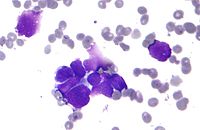
Photo from wikipedia
INTRODUCTION There is an ongoing need to identify various pathological factors that can predict various survival parameters in patients with upper tract urothelial carcinoma (UTUC). With this review, we aim… Click to show full abstract
INTRODUCTION There is an ongoing need to identify various pathological factors that can predict various survival parameters in patients with upper tract urothelial carcinoma (UTUC). With this review, we aim to scrutinize the impact of several pathological factors on recurrence free survival (RFS), cancer-specific survival (CSS) and overall survival (OS) in patients with UTUC. MATERIALS AND METHODS Systematic electronic literature search of various databases was conducted for this review. Studies providing multivariate hazard ratios (HR) for various pathological factors such as tumor margin, necrosis, stage, grade, location, architecture, lymph node status, lymphovascular invasion (LVI), carcinoma in situ (CIS), multifocality and variant histology as predictor of survival parameters were included and pooled analysis of HR was performed. RESULTS In this review, 63 studies with 35.714 patients were included. For RFS, all except tumor location (HR 0.94, p=0.60) and necrosis (HR 1.00, p=0.98) were associated with worst survival. All the pathological variables except tumor location (HR 0.95, p=0.66) were associated with worst CSS. For OS, only presence of CIS (HR 1.03, p=0.73) and tumor location (HR 1.05, p=0.74) were not predictor of survival. CONCLUSIONS We noted tumor grade, stage, presence of LVI, lymph node metastasis, hydronephrosis, variant histology, sessile architecture, margin positivity and multifocality were associated with poor RFS, CSS and OS. Presence of CIS was associated with poor RFS and CSS but not OS. Tumor necrosis was associated with worst CSS and OS but not RFS. Tumor location was not a predictor of any of the survival parameters.
Journal Title: International braz j urol : official journal of the Brazilian Society of Urology
Year Published: 2021
Link to full text (if available)
Share on Social Media: Sign Up to like & get
recommendations!